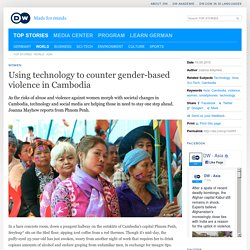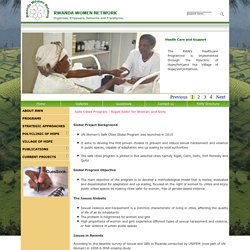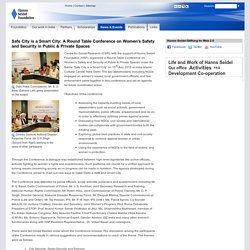

Trauma and Technology: The Role of ICT in Women's Safety and Mental Health Interventions. Using technology to counter gender-based violence in Cambodia. In a bare concrete room, down a pungent hallway on the outskirts of Cambodia's capital Phnom Penh, Sreyleap* sits on the tiled floor, sipping iced coffee from a red thermos.

Though it's mid-day, the puffy-eyed 25-year-old has just awoken, weary from another night of work that requires her to drink copious amounts of alcohol and endure groping from unfamiliar men, in exchange for meagre tips. As a karaoke bar employee, Sreyleap witnesses or experiences sexual assaults on a near-nightly basis. Rejecting unwanted advances is almost impossible when customers are drunk, she says; they react angrily, smashing glasses or yelling. But workplace abuse also takes more nuanced forms. Two months ago, Sreyleap was three months pregnant and eager for a second child. But having recently divorced her abusive husband, and earning just $60 per month to pay rent and support her five-year-old daughter, Sreyleap had little choice. An endemic problem Other cases of abuse are more visible to the public. Women Safety Using IOT - Innovation Jockeys 4. 12 engagements pour lutter contre le harcèlement sexiste et les violences sexuelles dans les transports en commun.
Femmes.gouv.fr | Publié le 9 juillet 2015 Alain Vidalies, secrétaire d’État chargé des Transports, de la Mer et de la Pêche, et Pascale Boistard, secrétaire d’État chargée des Droits des femmes, ont présenté le 9 juillet le « Plan national de lutte contre le harcèlement sexiste et les violences sexuelles dans les transports en commun » du gouvernement.

Ce plan développe 12 mesures concrètes pour lutter efficacement contre le harcèlement sexiste et les violences sexuelles dont sont victimes les femmes dans les transports en commun à travers trois axes : Il est le résultat de plusieurs mois de travail entre le ministère de l’Intérieur, le secrétariat d’Etat chargé des Transports, de la Mer et de la Pêche, le secrétariat d’Etat chargé des Droits des femmes et les transporteurs qui se sont régulièrement réunis depuis la création du groupe de travail dédié à la lutte contre les violences faites aux femmes dans les transports en décembre 2014. "From Smart Homes to women's safety, IoT can help our cities run better" - BW Smart Cities. March 27, 2015 0 0 0 Google +0 0 The Internet of Things (IoT) is generating as much interest as it is questions.

The idea of heterogeneous devices being able to communicate with each other through a variety of means is opening up a world of possibilities. RWANDA WOMEN NETWORK. Global Project Background UN Women’s Safe Cities Global Program was launched in 2010 It aims to develop the first proven models to prevent and reduce sexual harassment and violence in public spaces, capable of adaptation and up scaling by local authorities The safe cities program is piloted in five selected cities namely Kigali, Cairo, Delhi, Port Moresby and Quito Global Program Objective The main objective of the program is to develop a methodological model that is tested, evaluated and disseminated for adaptation and up scaling, focused on the right of women to utilize and enjoy public urban spaces by making cities safer for women, free of gender-based violence The Issues Globally Issues in Rwanda According to the baseline survey of sexual and GBV in Rwanda conducted by UNIFEM (now part of UN Women) in 2008 & IPAR scoping study Satellite view of KIMISAGARA showing layout of dwellings.

A Conversation About India’s Smart Cities: CONNECTKaro 2015 in Tweets. At this year’s CONNECTKaro conference, participants discussed a range of topics pertinent to sustainable urban development in India–including smart cities, buses, women’s safety, and safe access to mass transit.

Photo by Johann/Flickr. From April 15 – 16, 2015 over 300 experts—including government officials, policy makers, urban planners, and transport practitioners—participated in a global conversation about Smart Cities at CONNECTKaro 2015. Safe City is a Smart City: A Round Table Conference on Women's Safety and Security in Public & Private Spaces: Hanns-Seidel-Stiftung. Centre for Social Research (CSR), with the support of Hanns Seidel Foundation (HSF), organized a Round Table Conference on Women’s Safety and Security at Public & Private Spaces under the theme ‘Safe City is a Smart City’ on 15th July 2015 at India Islamic Cultural Centre, New Delhi.

The key stakeholders, including NGOs engaged on women’s issues, local government officials, and law enforcement came together in this conference and set an agenda for future coordinated action. Objectives of the conference: Through the Conference, a dialogue was established between high level dignitaries like police officials, activists fighting for women’s rights and academicians. Such platforms are crucial for a unified approach to solving issues concerning society as no progress can be made in isolation.
The agenda developed during the Conference aimed to chart out new ways to make Delhi a Safe and Smart City. There were two broad themes under which the Conference ensued. No closer than 2012: Women's Safety in Public Transport. UN Women Partnership Profile. UN Women – Field Office ESEAsia. Three-day consultation discusses good practices, tools and policies to make cities safer for women and girls Date: 12 June 2015 New Delhi - “Smart cities have to be safe for women and girls, and must reduce inequalities between women and men,” Union Minister for Urban Development M.

Venkaiah Naidu said at the inauguration of a three-day United Nations conference on ‘Safe Cities for Women and Girls – Implementation Essentials’ which began in New Delhi on 10 June. Union Minister for Urban Development Mr. M. “Urban life poses a number of risks with regard to the safety and security of women. Mr. The 100 Smart Cities Initiative will be rolled out on 25 June. The UN Women consultation included more than 120 participants from 24 countries, including from cities where the Safe Cities Global initiative is being implemented. Mr. Ms.